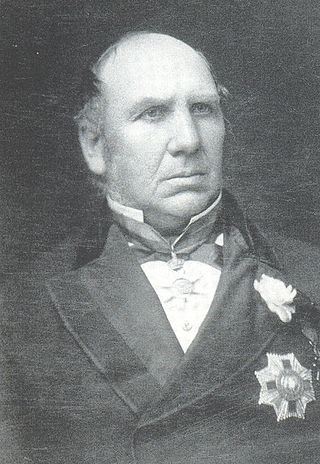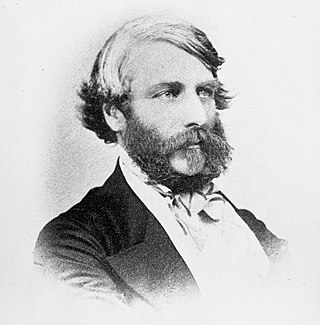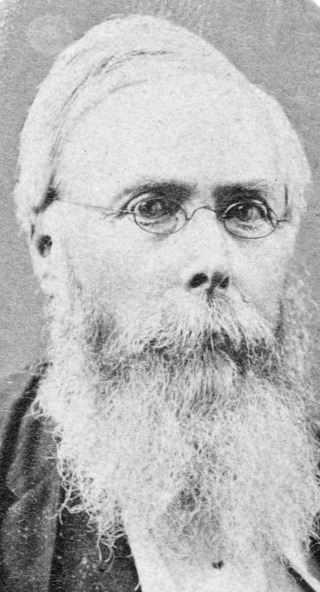
Sir James McCulloch, was a British colonial politician and statesman who served as the fifth premier of Victoria over four non-consecutive terms from 1863 to 1868, 1868 to 1869, 1870 to 1871 and 1875 to 1877. He is the third longest-serving premier in Victorian history.

Kilmore is a town in the Australian state of Victoria. Located 65 kilometres (40 mi) north of Melbourne, it is the oldest inland town in Victoria by the combination of age and physical occupation, and because it had unique agricultural attributes to drive that earliest settlement. It grew very rapidly to become four times bigger than its nearest inland rival by 1851. Its spectacular growth continued to match that of the major gold mining towns of Ballarat, Bendigo and Beechworth until at least 1861.

William Clark Haines, Australian colonial politician, was the first Premier of Victoria.

Sir John O'Shanassy, KCMG, was an Irish-Australian politician who served as the 2nd Premier of Victoria. O'Shanassy was born near Thurles in County Tipperary, Ireland, the son of a surveyor, and came to the Port Phillip District in 1839. He went into business in Melbourne as a draper, and by 1846 he was rich enough to be elected to the Melbourne City Council and to become the founding chairman of the Colonial Bank of Australasia. By the 1850s he was a major landowner and one of the wealthiest men in the colony. He also became a recognised leader of the large Irish Catholic community.

Bothwell, Tasmania is a small town with a population at the 2021 census of 499. Situated in central Tasmania on the River Clyde in a broad valley, it is notable for hunting and being a lake district. It is part of the municipality of Central Highlands Council and celebrated the bicentenary of its founding in 2022. Nearby locations include Hollow Tree, Hamilton, Ouse and Kempton.

William Thomas Napier Champ was a soldier and politician who served as the first Premier of Tasmania from 1856 to 1857. He was born in the United Kingdom.

William Pritchard Weston was the third Premier of Tasmania.

Sir William John Clarke, 1st Baronet, was an Australian businessman and philanthropist in the Colony of Victoria. He was raised to the baronetage in 1882, the first Victorian to be granted a hereditary honour.

Charles Hotson Ebden was an Australian pastoralist and politician, a member of the New South Wales Legislative Council, the Victorian Legislative Council and the Victorian Legislative Assembly.

Captain Sir Charles MacMahon was an Australian politician who twice served as Speaker of the Victorian Legislative Assembly and as Chief Commissioner of Victoria Police. MacMahon was born County Tyrone, Ireland, to a wealthy Irish family and served in the British army. He obtained a veterinary diploma in 1852, and soon left for Australia to join the gold rush. He arrived in Melbourne on 18 November 1852.

Sir Archibald Michie, was an English-born Australian lawyer, journalist, Agent-General, Attorney-General of Victoria and politician.
James Stewart Johnston was a Scottish-Australian businessman, newspaper owner and politician, a member of the Victorian Legislative Council November 1851 to December 1852 and the Victorian Legislative Assembly, October 1859 to August 1864.

Henry Miller was an Australian banker and politician, member of the Victorian Legislative Council.
Charles Myles Officer was an Australian grazier and politician, member of the Victorian Legislative Assembly.
Sir Robert Officer M.A., was an Australian politician and medical officer.

Ovens was an electoral district of the Legislative Assembly in the Australian state of Victoria from 1856 to 1927. It was based in northern Victoria, bordered by the Ovens River in the south-west and included the town of Beechworth, Victoria.

Richard Davies Ireland was an Australian politician, a member of the Victorian Legislative Assembly and Attorney-General.
This is a list of electoral results for the electoral district of Ovens in Victorian state elections.

The 1856 Victorian colonial election was held from 23 September to 24 October 1856 to elect the first Parliament of Victoria. All 60 seats in 37 electorates in the Legislative Assembly were up for election, though eight seats were uncontested. The eligibility to vote at the 1856 Victorian election was subject to a property qualification. The voting was carried out by secret ballot.
Ratho Farm Golf Links is an 18-hole golf course that was constructed on the Ratho Farm in Bothwell, Tasmania.














